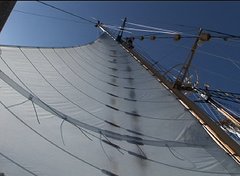The sun is finally shining on our voyage and the Trade winds are blowing at18-20 knots making our sailing under the four lowers and occasional Jib Topsail spectacular and colors vibrant. Oceanographic science has taken off quickly aboard the Stanford@SEA voyage with 6 stations (am and pm) already processed and in the bank. 9 teams of student projects are occurring on this cruise and the first 3 teams- focusing on spectacular eddies created by the island mass effect around the Hawaiian Islands, a second team investigating why white sharks linger in offshore waters south of the archipelago have gone into full gear. A third team is analyzing the water collected for eDNA- forensically identifying who and what swims in the waters from the tiny bits of cells they shed. Each night we run a "hydrocast" and collect samples from the Nisken bottles that automatically sample 2L of water and our instrumentation attached to the hydrocast frame collects conductivity, pressure and temperature data- the physical oceanographic data that helps us read the waters beneath or ship.
This is followed by
a meter net tow that is sent down
to the deep scattering layer- a thick layer we can acoustically see as our ADCP
profiler sends sound down that bounces off the air bladders of the critters
swimming in these layers. We can scoop a little bit of the ocean up with our
Meter Net which we carefully put out two times a day down to depth as deep as
400m- for later
analyses to complement the abiotic data we are taking.
Once the samples are on deck from the depths we measure
pH, oxygen, nitrate, phosphate and complement this with eDNA sampling. We have taken almost 8 hydrocasts and 6 net
tows- we've run 6 eDNA stations trying to find clues as to what backboned fish
and mammals utilize these waters- by isolating their dna as they swim by. Sequencing has commenced and shortly here
aboard the RCS we'll know who is below us to complement the visual IDs in the
net.
Students are quickly learning their lines and doing all
the sail handling with their mates leading the way- it's an exciting time
aboard the ship as full operations have commenced and the sailing is easy!
Dr. Barbara Block
Stanford Professor &
Chief Scientist S303






No comments:
Post a Comment